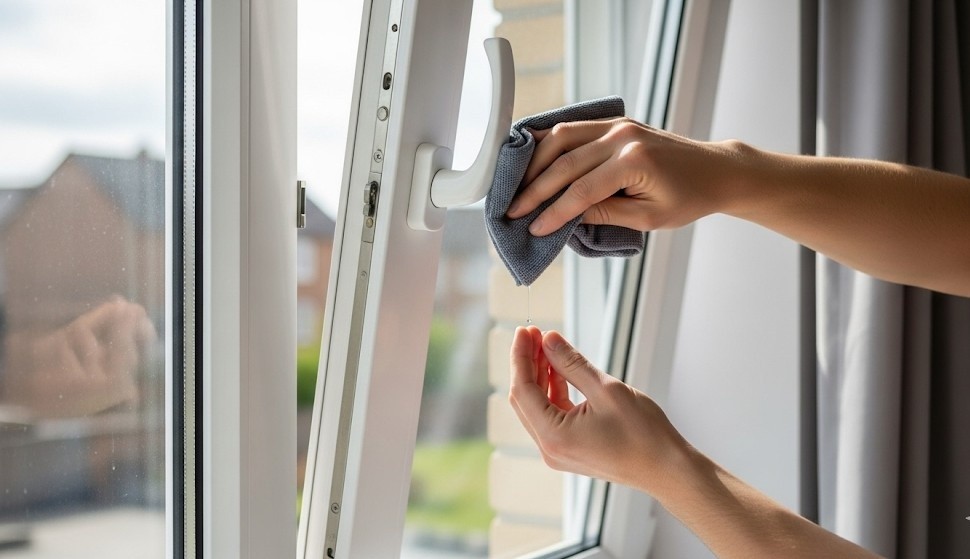Key Takeaways
- Regular cleaning, lubrication, and seal inspections prevent drafts, leaks, and hardware stiffness in uPVC crank-out windows.
- Clean every 3–4 months with mild soap and microfiber; avoid abrasive cleaners, solvents, and pressure washing.
- Lubricate hinges and cranks every 6–12 months using silicone spray; avoid petroleum-based oils and grease.
- Seals last 5–7 years; inspect every 6 months for cracks or air leaks and replace when worn to maintain efficiency.
Many homeowners and builders invest in uPVC crank-out windows also known as casement windows for their durability, energy efficiency, and sleek outward-opening design. But even the strongest windows can lose performance if they aren’t properly maintained. Dirt buildup, stiff handles, and worn seals can turn a once-smooth system into a frustrating and costly problem.
Neglecting maintenance doesn’t just affect appearance. It impacts insulation, comfort, and long-term value. A small crack in the seal or a clogged drainage channel can quietly increase energy bills, cause leaks, or even shorten the lifespan of your windows. For wholesalers and builders, that means dissatisfied clients and unnecessary replacement costs.
The good news? Regular upkeep is simple, affordable, and highly effective. In this guide, we’ll break down the most essential maintenance practices from cleaning and lubrication to seal inspections and professional servicing that will keep your uPVC crank-out windows performing like new for decades.
Why Regular Maintenance Matters
Even though uPVC is low-maintenance compared to wood or aluminum windows, routine care is still essential.
Benefits of Regular Care
- Longevity: Prevents unnecessary wear and tear.
- Efficiency: Keeps seals airtight, improving insulation.
- Aesthetics: Maintains a clean and polished look.
- Cost savings: Reduces repair and replacement expenses.
Neglect can lead to stiff handles, drafty seals, or water damage issues that are costly to repair but easy to prevent.
How to Clean uPVC Crank-Out Windows
Cleaning Frequency
Clean windows every 3–4 months, or more often in coastal or dusty environments.
What to Use
- Mild soap mixed with warm water.
- A soft microfiber cloth or sponge.
- Soft brush for corners and drainage holes.
What to Avoid
- Abrasive sponges.
- Harsh chemical cleaners.
- High-pressure washers.
Tip: Always dry frames after cleaning to prevent trapped moisture.
Comparison Table: Cleaning Methods
| Method | Recommended | Reason |
| Mild soap & water | Yes | Gentle and safe for both frames and glass. |
| Microfiber cloth | Yes | Non-abrasive, prevents scratches. |
| Bleach / solvents | No | Too harsh, can damage the uPVC surface. |
| Pressure washing | No | Forces water into seals, may cause leaks. |
For additional care tips, see this maintenance guide.
Lubrication Tips for Smooth Operation
uPVC crank-out windows rely on moving parts like hinges, cranks, and locking points. Over time, friction builds, making operation harder.
When to Lubricate
- Every 6–12 months.
- After heavy rainfall or seasonal changes.
Recommended Lubricants
- Silicone-based spray (best choice).
- Avoid petroleum-based oils and grease.
Comparison Table: Lubricant Types
| Lubricant Type | Recommended | Pros | Cons |
| Silicone spray | Yes | Long-lasting, repels dust | Slightly more expensive |
| WD-40 / oil-based | No | Easy to find | Attracts dirt, short-term fix |
| Grease | No | Provides heavy coating | Too thick, can clog parts |
Keeping hinges and handles lubricated ensures your uPVC crank-out windows remain easy to operate.
uPVC Window Seal Maintenance Tips
Role of Seals
Seals block drafts and prevent moisture infiltration. They’re critical to energy efficiency.
Inspection Routine
- Check seals every 6 months.
- Look for cracks, peeling, or brittle rubber.
- Run your hand along closed windows to detect air leaks.
Replacement Cycle
- Seals last 5–7 years on average.
- Harsh climates may shorten this timeline.
Reliable seals ensure products deliver maximum insulation and comfort.
Keeping Drainage and Ventilation Clear
Drainage Channels
Crank-out windows include built-in drainage holes that prevent rainwater accumulation.
- Inspect during cleaning.
- Clear blockages with a soft brush or cotton swab.
- Test by gently pouring water near the outlet.
Ventilation Benefits
- Reduces condensation on glass.
- Improves indoor air quality.
A clear drainage system helps extend the life of uPVC windows.
Routine Inspections and Minor Repairs
What to Check
- Loose or stiff handles.
- Hinges for smooth movement.
- Cracks in frames or glass.
- Signs of condensation between panes.
DIY vs Professional Repairs
|
Task |
DIY Friendly |
Professional Recommended |
| Cleaning frames & glass | Yes | – |
| Lubricating hinges | Yes | – |
| Replacing seals | Maybe | Yes |
| Fixing crank mechanism | No | Yes |
| Realignment of frames | No | Yes |
Protecting Glass and Frames
Scratch Prevention
- Use soft materials only.
- Avoid sharp tools for cleaning.
UV and Moisture Protection
- Apply UV-protective films for sun-exposed windows.
- Reseal caulking around frames every few years.
Coastal Environments
Salt exposure requires more frequent maintenance. For added durability, some projects also use uPVC sliding windows in coastal regions.
DIY Maintenance vs Professional Care
Basic upkeep is simple, but professional servicing ensures maximum reliability.
Comparison: DIY vs Professional Care for uPVC Crank-Out Windows
| Task / Activity | DIY Suitable | Professional Recommended |
Why It Matters |
| Cleaning frames & glass | Yes | – | Keeps windows spotless and free of buildup. |
| Lubricating hinges & crank parts | Yes | – | Prevents stiffness and hardware wear. |
| Tightening screws & handles | Yes | – | Quick fix to avoid loose fittings. |
| Replacing seals & weatherstrips | Possible | Yes | Precise fitting extends insulation performance. |
| Fixing crank or locking mechanism | No | Yes | Requires technical skill and spare parts. |
| Frame realignment / adjustments | No | Yes | Ensures efficiency, prevents drafts. |
| Full structural inspection | No | Yes | Identifies hidden damage and ensures compliance. |
Choosing a Reliable uPVC Window Supplier
When it comes to long-term performance, choosing the right supplier is just as important as proper maintenance. A reliable partner ensures product quality, compliance with international standards, and the flexibility to meet project-specific needs. For wholesalers and builders, this means fewer callbacks, smoother installations, and long-term client satisfaction.
One company that consistently delivers on these standards is Oridow, a China-based manufacturer specializing in uPVC crank-out windows,sliding windows, and a broad range of custom fenestration products. With recognized certifications and a reputation for customization, Oridow supports both residential and commercial projects across global markets.
Professionals trust Oridow not only for durability but also for design flexibility and bulk supply capabilities. These qualities are highlighted in the top 5 reasons industry leaders continue to choose Oridow’s uPVC systems for large-scale projects.
Frequently Asked Questions (FAQs)
1. How often should I clean uPVC crank-out windows?
Every 3–4 months, or more often in coastal or dusty environments.
2. What’s the best lubricant for window hardware?
The ideal option is a silicone-based spray, as it keeps moving parts smooth without attracting dust.
-
Long-lasting and weather-resistant
-
Safe for hinges, cranks, and locks
-
Doesn’t leave sticky residue like oils
Avoid oil-based lubricants such as WD-40, which may attract dirt and cause buildup over time.
3. How do I know if my seals need replacing?
Window seals usually last 5–7 years, but signs of wear can appear sooner depending on climate and use. Look out for:
-
Cracks or brittleness in the rubber
-
Peeling or detachment from the frame
-
Drafts or noticeable airflow when closed
If you notice any of these, it’s time to replace the seals to maintain insulation and efficiency.
4. Does Oridow provide window solutions for large-scale projects?
Yes. Oridow specializes in bulk supply for wholesalers, developers, and architects. Their wide range of products includes uPVC and aluminum windows and doors tailored for both residential and commercial applications.
5. Can I replace seals myself?
DIY is possible but not always precise. Professionals ensure a better fit and durability.
6. Why are my windows hard to crank open?
Difficulty in opening usually points to either lack of lubrication or worn-out hardware.
-
Hinges or crank parts may be dry and need silicone spray
-
Dust or dirt buildup could be restricting smooth movement
-
Worn gears or damaged mechanisms may require replacement
Start with lubrication. If the problem continues, it’s best to call a professional.
7. Do uPVC windows need professional servicing?
Yes, regular servicing helps maintain efficiency and extend the lifespan of uPVC crank-out windows. Recommended frequency: every 2–3 years.
-
Realignment of frames for smooth operation
-
Seal and weatherstrip replacement to prevent drafts
-
Full structural and hardware inspection for hidden issues
Professional care ensures the windows continue to perform at their best.
8. Are uPVC crank-out windows energy-efficient?
Yes. When seals are intact, they provide excellent insulation and ventilation.
9. How do I maintain windows in coastal regions?
Clean and inspect more frequently every 2–3 months due to salt exposure.





